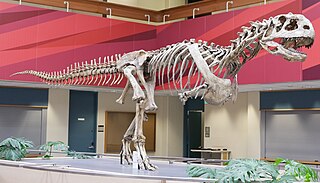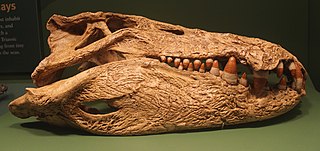
Abelisauroidea is a diverse superfamily of ceratosaurian dinosaurs, typically regarded as a Cretaceous group, though the earliest abelisaurid remains are known from the Middle Jurassic of Argentina and possibly Madagascar. Possible Abelisauridae remains were also discovered in Late Jurassic Tendaguru Beds in Tanzania.

Mahajangasuchus is an extinct genus of crocodyliform which had blunt, conical teeth. The type species, M. insignis, lived during the Late Cretaceous; its fossils have been found in the Maevarano Formation in northern Madagascar. It was a fairly large predator, measuring up to 4 metres (13 ft) long.

Mariliasuchus is an extinct genus of Late Cretaceous notosuchian crocodyliforms found near Marilia, Brazil. The first bone remains were found and collected in 1995 by Brazilian paleontologist William Nava, in red rocks from the fossiliferous Adamantina Formation. Four years later, it was described as Mariliasuchus amarali, by Brazilian paleontologists Ismar de Souza Carvalho and Reinaldo J. Bertini.
Itasuchus is an extinct genus of crocodyliforms from the Late Cretaceous of Brazil. Fossils of the type species I. jesuinoi, first described in 1955 by Llewellyn Ivor Price, have been found from the Serra da Galga Formation in Uberaba, Brazil.

Montealtosuchus was an extinct genus of terrestrial crocodyliform. It was discovered in 2004 in the Bauru Basin of Brazil, from Campanian-Maastrichtian deposits of the Adamantina Formation. The species was described in 2007, and assigned to the family Peirosauridae. The type species is M. arrudacamposi. The genus takes its name from the type locality in Monte Alto municipality.

Sphagesaurus is an extinct genus of sphagesaurid notosuchian crocodylomorph from the Late Cretaceous of southwest São Paulo, southern Brazil.
The Adamantina Formation is a geological formation in the Bauru Basin of western São Paulo state, in southeastern Brazil.
Trematochampsidae is an extinct family of mesoeucrocodylian crocodyliforms. Fossils are present from Madagascar, Morocco, Niger, Argentina, and Brazil. Possible trematochampsids have been found from Spain and France, but classification past the family level is indeterminant. The trematochampsids first appeared during the Barremian stage of the Early Cretaceous and became extinct during the late Maastrichtian stage of the Late Cretaceous.

Morrinhosuchus is an extinct genus of notosuchian crocodyliform from the Late Cretaceous Adamantina Formation of Brazil. It is known from a mandible and a portion of the front of the skull collected from the municipality of Monte Alto in São Paulo state. Morrinhosuchus refers to Morrinho de Santa Luzia, a hill nearby the collection site of the holotype, while luziae refers to the chapel of Santa Luzia, which is located on top of the hill.

Susisuchus is an extinct genus of neosuchian mesoeucrocodylian crocodyliform from the Early Cretaceous of Brazil. Fossils have been found from the Nova Olinda Member of the Aptian-age Crato Formation in the Araripe and Lima Campos Basins of northeastern Brazil. Named in 2003, Susisuchus is the sole member of the family Susisuchidae, and is closely related to the clade Eusuchia, which includes living crocodilians. The type species is S. anatoceps, known from a single partial articulated skeleton that preserves some soft tissue. A second species, S. jaguaribensis, was named in 2009 from fragmentary remains.
Pepesuchus is an extinct genus of carnivorous metasuchian from the Late Cretaceous period. It is a peirosaurid which lived during the Campanian and Maastrichtian stages of the Late Cretaceous in what is now state of São Paulo, Brazil. It was a semiaquatic crocodylomorph.

Campinasuchus is an extinct genus of baurusuchid mesoeucrocodylian from Minas Gerais State of Brazil.

Caipirasuchus is an extinct genus of sphagesaurid notosuchians known from the Late Cretaceous of northern São Paulo State, southeastern Brazil. The type species, C. paulistanus, was named in 2011. A second species, C. montealtensis, was referred to Caipirasuchus in 2013 after having been named in 2008 as a species of Sphagesaurus. A third species, C. stenognathus, was described in 2014. A fourth species, C. mineirus, was described in 2018. A fifth species, C. attenboroughi, was named in 2021 in honour of David Attenborough.
Labidiosuchus is an extinct genus of notosuchian crocodyliforms from Minas Gerais State, southeastern Brazil. Labidiosuchus had a very bizarre dentition and its lower jaw had a Y-shaped outline.
Itasuchidae is a Gondwanan family of crocodyliforms that lived during the Cretaceous period. It was a clade of terrestrial crocodyliforms that evolved a rather dog-like form, and were terrestrial carnivores.

Aplestosuchus is an extinct genus of baurusuchid mesoeucrocodylian known from the Late Cretaceous Adamantina Formation of São Paulo, southern Brazil. It contains a single species, Aplestosuchus sordidus. A. sordidus is represented by a single articulated and nearly complete skeleton, preserving the remains of an unidentified sphagesaurid crocodyliform in its abdominal cavity. The specimen represents direct evidence of predation between different taxa of crocodyliforms in the fossil record.

Thanos is a genus of carnivorous brachyrostran abelisaurid dinosaur that lived in Brazil during the Santonian stage of the late Cretaceous Period. It contains only a single species known as T. simonattoi.

Arrudatitan is an extinct genus of titanosaur sauropod dinosaur known from the Late Cretaceous (Campanian-Maastrichtian)-aged Adamantina Formation of Brazil. The type species, A. maximus, was named and described in 2011 as a species of Aeolosaurus, but was separated into its own genus in 2021. It was relatively gracile for a titanosaur.
Ibirania is a genus of dwarf saltasaurine titanosaur dinosaur from the Late Cretaceous São José do Rio Preto Formation of Southeast Brazil. The type species is Ibirania parva. It is one of the smallest sauropods known to date, comparable in size to the titanosaur Magyarosaurus.
Titanochampsa is a genus of large mesoeucrocodylian from the Maastrichtian Marilia Formation of Brazil. Although only known from a single skull roof, the material shows that Titanochampsa was not a member of Notosuchia, which were previously believed to have been the only crocodyliforms present in the strata of the Bauru Group. Body size estimates vary greatly and range between 2.98–5.88 m due to the incomplete nature of the holotype fossil. The overall anatomy of the skull roof, alongside its size and possible affinities with Neosuchians, may suggest that it was a semi-aquatic ambush hunter similar to modern crocodilians.













